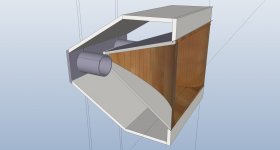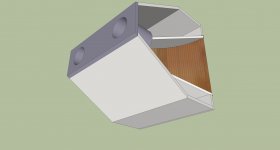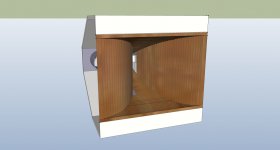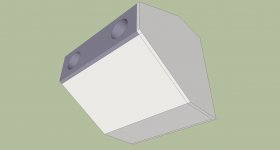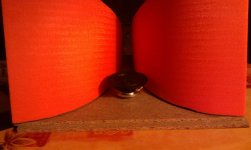Wow SB65WBAC25-4 version looks good and thanks for PCD guide here and over the other thread.
Did a quality check comparison your acoustic measurements to approx. same electric slopes made in Rephase and imported to REW and XSim. REW ones below is set same scales as your live ones for easy comparison, filters are electric woofer slopes BW2 48Hz - BW4 500Hz and tweeter slopes BS2 500Hz - 20kHz. In REW tweeter IR is delayed 1,0mS before summed A+B with woofer and in XSim tweeter is delayed 13,5 inch.
Thanks Byrtt! That looks very familiar! 🙂
Give PCD a try - it generates target curves with a push of a button so no need to generate in another program and to import.
@Bwaslo: given you do it by eye could be one reason the "generate textbook overlay" is not currently a feature in Xsim. If you ever have time - that would be a great feature to add. -thanks.
It is more lilely to blow speakers then a modern amplifier these days.
XR I am go closed or helmholz for this reason a open baffle has a soft bas output while your horn is fast, this dipoles do even not put room modes on that is why she are interesting for nabures😛
also with such a system your speakers are not protected by big x max output when listen to for example a movie.
Try to load the woofer with the back port so it do act as a kind of tl or helmholz it will be a other story.
regards
Turning that big back vent to a damped and tapered TL is very interesting. I recently made a PMC style TL and it works very well to extract deep bass with low GD and fantastic cone control. I could play EDM on my little 5.25in woofers with nice bass and cones hardly move. Requires a damped line though - not open.
There are those who say proper transients in loudspeakers only happens with a sealed box or IB. What do you think of this? I ask only because the idea of an OB / Trynergy...synergy is now on the table.
Not only transients but impact on bass strong feeling bass, a puching bass so to speak, a ob do not have that.
But idea is nice, and I go afcourse try it. The open sound without stress is a very nice side effect of a bass dipole
but do watch out for the peak, stay below that.
regards
I suppose making a sealed back lid to see how that changes things is easy enough. Maybe I will try that but I have to say it sounds pretty nice in OB right now.
Extended listening impressions of the new uTrynergy with SB65WBAC25 and dipole back and improved Harsch XO.
Again, here is the measured phase plot and it makes all the difference:
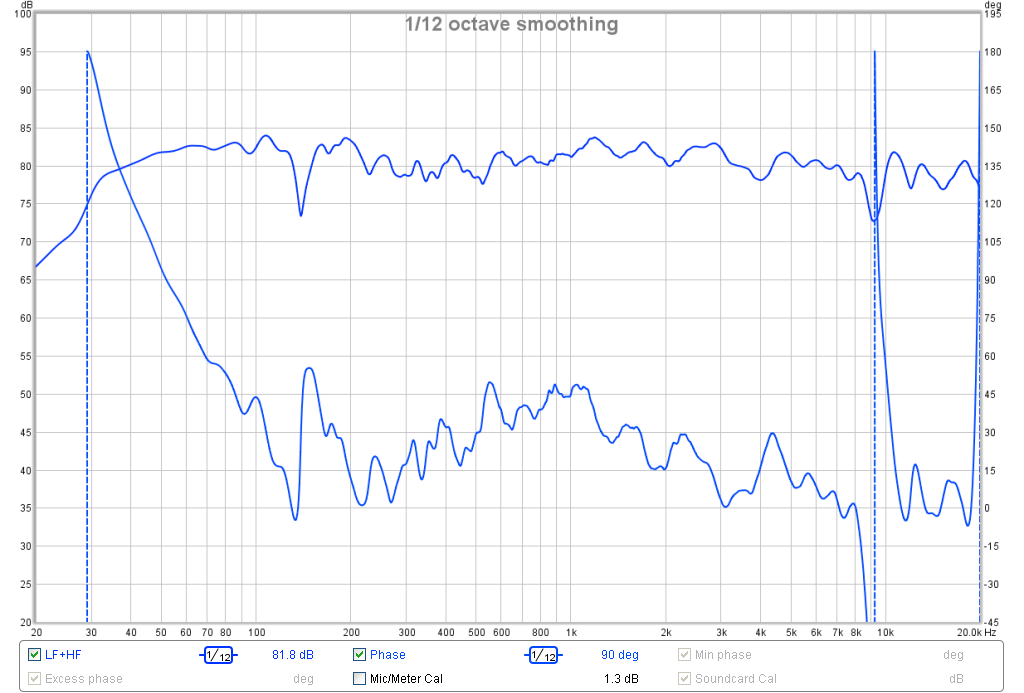
Fantastically superb sounding with all genres - because the response is flat within a 5dB band from 40Hz to 20kHz. Truly a full range speaker. I could hear the deep rumble of the floor boards on Eric Clapton's unplugged album. Clapton's acoustic guitar is super lifelike. Jazz trio has excellent dynamics and transient perfection on pianos and drums. It goes without saying that latest pop songs have superb intelligibility of vocals that horns and waveguides are known for. Even EDM tracks manage to play well with thumping bass lines and shattering synthesizer mids and highs. Infected Mushroom works well here as well as Knife Party. I can only imagine in stereo the sound would be even more amazing. The nearly flat phase from 200Hz to 8kHz really makes a difference as well as the lower distortion performance of the SB65WBAC25 vs the smaller W2-852SH. The deep 2.5mm xmax on the SB65WBAC25 really gives the room to accommodate a 1st order electrical XO at 300Hz.
My favorite part is the deep deep bass I can get without a sub woofer from four 5.25in woofers that were only supposed to take it down to 100Hz. The bass is dipole so it shakes the room less than a regular monopole woofer, but the transients are tight and clear on kick drums and bass guitar or stand up bass and you do hear and feel the bass down to circa 40Hz. It's true that in OB configuration there is no cone motion control on the back so higher SPL's will not be possible - but this smaller box in OB is perfect for domestic SPL levels - certainly capable of hitting 105dB.
Again, here is the measured phase plot and it makes all the difference:

Fantastically superb sounding with all genres - because the response is flat within a 5dB band from 40Hz to 20kHz. Truly a full range speaker. I could hear the deep rumble of the floor boards on Eric Clapton's unplugged album. Clapton's acoustic guitar is super lifelike. Jazz trio has excellent dynamics and transient perfection on pianos and drums. It goes without saying that latest pop songs have superb intelligibility of vocals that horns and waveguides are known for. Even EDM tracks manage to play well with thumping bass lines and shattering synthesizer mids and highs. Infected Mushroom works well here as well as Knife Party. I can only imagine in stereo the sound would be even more amazing. The nearly flat phase from 200Hz to 8kHz really makes a difference as well as the lower distortion performance of the SB65WBAC25 vs the smaller W2-852SH. The deep 2.5mm xmax on the SB65WBAC25 really gives the room to accommodate a 1st order electrical XO at 300Hz.
My favorite part is the deep deep bass I can get without a sub woofer from four 5.25in woofers that were only supposed to take it down to 100Hz. The bass is dipole so it shakes the room less than a regular monopole woofer, but the transients are tight and clear on kick drums and bass guitar or stand up bass and you do hear and feel the bass down to circa 40Hz. It's true that in OB configuration there is no cone motion control on the back so higher SPL's will not be possible - but this smaller box in OB is perfect for domestic SPL levels - certainly capable of hitting 105dB.
Last edited:
Funny you should mention that particular track. It's one I played yesterday for an entirely different reason 🙂.
Due to a post by Joachim Gerhard pointing at the B&O blog: B&O Tech: Why select one driver over another? (Part 1) earfluff and eyecandy
I stumbled over this piece of information:
As posted on this blog:Test Tracks: What not to play! earfluff and eyecandy
Conveniently named: what not to play!
Even Nora Jones gets hit pretty hard on that page!
What Happened To Dynamic Range?
I can't say I disagree completely... makes you think, doesn't it? 🙂
Due to a post by Joachim Gerhard pointing at the B&O blog: B&O Tech: Why select one driver over another? (Part 1) earfluff and eyecandy
I stumbled over this piece of information:
Geoff from B&O said:Interestingly, I have certainly heard cases where a good loudspeaker can make a recording sound worse than it is. Specifically, it is not difficult to buy home loudspeakers (or headphones) that have more bass at lower frequency ranges than some studio monitors. As a result, you might hear content or artefacts in the low end that they did not hear in the recording or mastering studios. Had they heard it there, they might have decided to remove the low end problems. A good example of this is Eric Clapton’s “Unplugged” album. This has a very low frequency ringing/rumble in it that sounds very much like the sound of a tapping foot causing a microphone stand to vibrate and shake a microphone. On “normal” loudspeakers, this is inaudible (as I suspect it was in the studios where it was recorded and mastered) but on large loudspeakers with unusually low low-frequency ranges, this is very audible, and very annoying.
As posted on this blog:Test Tracks: What not to play! earfluff and eyecandy
Conveniently named: what not to play!
Even Nora Jones gets hit pretty hard on that page!
With more background information to be found here:Geoff from B&O said:Artist: Norah Jones
Album: Come away with me
Tracks: All of them
Why: I like the tunes and the performances on this album, and the kick drum on “Turn me On” is great. However, there is massive distortion problems on the vocals all the way through this album. I don’t know what happened, but it sounds a little like someone was clipping the mic preamp on the vocal microphone. What mystifies me even more is that this album won a Grammy for Record of the Year which is awarded no only to the artist, but to the producer and engineer – both of whom should have known better.
What Happened To Dynamic Range?
I can't say I disagree completely... makes you think, doesn't it? 🙂
The rumble is much more pronounced when I have my low distortion bass horn running - it sounds so realistic that I thought someone was walking around upstairs. I don't find it annoying though. I do agree that Norah Jones Come Away with Me, her voice sounds distorted sometines like it got warbled. Nonetheless it was pretty much unanimously approved by listeners in all the Blind Subjective test threads.
Oh but the point is that this 2-way little Trynergy can reproduce part of that low frequency rumble - impressive reach. Actually, I am still a bit perplexed by the deep bass extension of this speaker. It was not expected and I suspect that the small volume wrap around enclosure tapering to the back may actually be acting like an enclosure similar to a W frame slot loaded dipole sub woofer.
Oh but the point is that this 2-way little Trynergy can reproduce part of that low frequency rumble - impressive reach. Actually, I am still a bit perplexed by the deep bass extension of this speaker. It was not expected and I suspect that the small volume wrap around enclosure tapering to the back may actually be acting like an enclosure similar to a W frame slot loaded dipole sub woofer.
Last edited:
Personally I like the rumble too. makes you feel a "live" witness of the performance.
I also like finding old (or less old) recordings that don't have the mic. output high passed entertaining, like on: Etta James - I Just Want to Make Love to You
Gotta hear that one to know what I'm talking about. The lower (and clearer) your system goes, the more you find stuff like this. I can think of a few.
I do agree about Norah's voice. There's definitely something going on. Made me remember the discussion of that track.
I also like finding old (or less old) recordings that don't have the mic. output high passed entertaining, like on: Etta James - I Just Want to Make Love to You
Gotta hear that one to know what I'm talking about. The lower (and clearer) your system goes, the more you find stuff like this. I can think of a few.
I do agree about Norah's voice. There's definitely something going on. Made me remember the discussion of that track.
#xrk971
some question about port in inches, do you mean here 7 inch wide? and 17 inch long? I am very bad in calculate things, always had.
I did try to put it in cm it is more easy with me, like 7 x 0.01 and 17 x 0.01.
7 inch wide do not fit so when I do 7 x 0.0254 = 0,1778 cm is little small so I do not understand it well here.
BR_dia=7.0*0.0254; | BR port dia inches
BR_len=17.0*0.0254; | BR port length inches
thanks.
some question about port in inches, do you mean here 7 inch wide? and 17 inch long? I am very bad in calculate things, always had.
I did try to put it in cm it is more easy with me, like 7 x 0.01 and 17 x 0.01.
7 inch wide do not fit so when I do 7 x 0.0254 = 0,1778 cm is little small so I do not understand it well here.
BR_dia=7.0*0.0254; | BR port dia inches
BR_len=17.0*0.0254; | BR port length inches
thanks.
Wesayso,
http://www.cdmasteringservices.com/dynamicrange.htm
Great link on what happened to dynamic range or the loudness wars. I have a cousin who works for the music industry as a producer and song writer. He works with really big names and labels in the pop genre. I asked him what happened to the dynamic range in pop and what happened. He is in fact, very aware of this problem, and as an artist and producer - does not want his music to sound compressed but guess who makes the decision as to how loud to set the recording? The finance guys who say we have to be louder to be selected because that what sells songs. Louder = $. He has no choice but to comply and compress the track. He came over one day and listened to my speakers and said he was blown away by the sound quality. He wants a pair of my big synergy style horns and bass horn sub for his home system.
This loudness is the problem I can't stand listening to the Pop channels on the streaming music. It literally puts my brain into lockup and I can't think. I always have to turn it down when someone in my family plays it in the car when I drive.
There are a few exceptions lately - mostly acoustic pop that don't have the average level smashed to -3dB full scale.
http://www.cdmasteringservices.com/dynamicrange.htm
Great link on what happened to dynamic range or the loudness wars. I have a cousin who works for the music industry as a producer and song writer. He works with really big names and labels in the pop genre. I asked him what happened to the dynamic range in pop and what happened. He is in fact, very aware of this problem, and as an artist and producer - does not want his music to sound compressed but guess who makes the decision as to how loud to set the recording? The finance guys who say we have to be louder to be selected because that what sells songs. Louder = $. He has no choice but to comply and compress the track. He came over one day and listened to my speakers and said he was blown away by the sound quality. He wants a pair of my big synergy style horns and bass horn sub for his home system.
This loudness is the problem I can't stand listening to the Pop channels on the streaming music. It literally puts my brain into lockup and I can't think. I always have to turn it down when someone in my family plays it in the car when I drive.
There are a few exceptions lately - mostly acoustic pop that don't have the average level smashed to -3dB full scale.
Last edited:
#xrk971
some question about port in inches, do you mean here 7 inch wide? and 17 inch long? I am very bad in calculate things, always had.
I did try to put it in cm it is more easy with me, like 7 x 0.01 and 17 x 0.01.
7 inch wide do not fit so when I do 7 x 0.0254 = 0,1778 cm is little small so I do not understand it well here.
BR_dia=7.0*0.0254; | BR port dia inches
BR_len=17.0*0.0254; | BR port length inches
thanks.
I am not sure where you got this but it may have been a way to "kluge" or fake the effect of an open back enclosure by making the ports huge to reduce any effect they would have had as a bass reflex port. Yes it is 17inches and 7inches. Akabak by default uses meters as length. In some functions like radiator specifications where we say what the baffle width is or where the acoustic center is located units of inches or other units are allowed if specified. If left as a plain number then meters is assumed.
X I have do change the meters in akabak so I can more easy find the ports.
like this if I did it right. gave the same outcome.
| *** tractrix profile from E. Forker's Tractrix spreadsheet for 300 Hz horn ***
|S_throat(m^2), S_mouth (m^2), Length (cm)
S1T=0.005041000; S1M=0.007076077; L1=5.19*0.01;
S2T=0.007076077; S2M=0.009688764; L2=4.79*0.01;
S3T=0.009688764; S3M=0.013530724; L3=5.06*0.01;
S4T=0.013530724; S4M=0.01865877; L4=4.83*0.01;
S5T=0.01865877; S5M=0.026128549; L5=5.01*0.01;
S6T=0.026128549; S6M=0.037115109; L6=5.14*0.01; | Bass front horn injection point at 24.88cm, node=56
S7T=0.037115109; S7M=0.052727978; L7=5.01*0.01;
S8T=0.052727978; S8M=0.075596059; L8=4.95*0.01;
S9T=0.075596059; S9M=0.111944519; L9=5.05*0.01;
S10T=0.111944519; S10M=0.138052394; L10=2.48*0.01;
S11T=0.138052394; S11M=0.154466426; L11=1.24*0.01;
S12T=0.154466426; S12M=0.173785319; L12=1.23*0.01;
S13T=0.173785319; S13M=0.197408872; L13=1.22*0.01; | Bass Reflex injection point at 49.98cm, node=63
S14T=0.197408872; S14M=0.230483934; L14=1.29*0.01;
S15T=0.230483934; S15M=0.266119447; L15=0.92*0.01;
S16T=0.266119447; S16M=0.300380595; L16=0.43*0.01; |0.526m long
For the synergy I did tought about do reflexports on the back?, and then corner loaded, maybe it give
more control about the cone.
regards
like this if I did it right. gave the same outcome.
| *** tractrix profile from E. Forker's Tractrix spreadsheet for 300 Hz horn ***
|S_throat(m^2), S_mouth (m^2), Length (cm)
S1T=0.005041000; S1M=0.007076077; L1=5.19*0.01;
S2T=0.007076077; S2M=0.009688764; L2=4.79*0.01;
S3T=0.009688764; S3M=0.013530724; L3=5.06*0.01;
S4T=0.013530724; S4M=0.01865877; L4=4.83*0.01;
S5T=0.01865877; S5M=0.026128549; L5=5.01*0.01;
S6T=0.026128549; S6M=0.037115109; L6=5.14*0.01; | Bass front horn injection point at 24.88cm, node=56
S7T=0.037115109; S7M=0.052727978; L7=5.01*0.01;
S8T=0.052727978; S8M=0.075596059; L8=4.95*0.01;
S9T=0.075596059; S9M=0.111944519; L9=5.05*0.01;
S10T=0.111944519; S10M=0.138052394; L10=2.48*0.01;
S11T=0.138052394; S11M=0.154466426; L11=1.24*0.01;
S12T=0.154466426; S12M=0.173785319; L12=1.23*0.01;
S13T=0.173785319; S13M=0.197408872; L13=1.22*0.01; | Bass Reflex injection point at 49.98cm, node=63
S14T=0.197408872; S14M=0.230483934; L14=1.29*0.01;
S15T=0.230483934; S15M=0.266119447; L15=0.92*0.01;
S16T=0.266119447; S16M=0.300380595; L16=0.43*0.01; |0.526m long
For the synergy I did tought about do reflexports on the back?, and then corner loaded, maybe it give
more control about the cone.
regards
Kees,
That's almost exactly how I made the box for the uTrynergy. One note is that I needed to reduce the volume so I sealed off the volume enclosed by the curved wall and the flat panels that hold the woofers. It made for a tapered almost like the tail of an airfoil leading to the back where flows from both sides of the horn backsides combine before exiting out the open back. For your application, depending on driver Vas and what volume you need, you may leave open or closed. It's a good place to add filler volume blocks to precisely set the volume and Qts of the sealed or vented box. Your two rear vents is what I was also thinking of. We have same idea.
That's almost exactly how I made the box for the uTrynergy. One note is that I needed to reduce the volume so I sealed off the volume enclosed by the curved wall and the flat panels that hold the woofers. It made for a tapered almost like the tail of an airfoil leading to the back where flows from both sides of the horn backsides combine before exiting out the open back. For your application, depending on driver Vas and what volume you need, you may leave open or closed. It's a good place to add filler volume blocks to precisely set the volume and Qts of the sealed or vented box. Your two rear vents is what I was also thinking of. We have same idea.
And you even can swap the rear ports by variovents if you like !
Groovy! That damps the cone very well because of the resistance action. you need to seal of the wideband driver on mouth
otherwise it will lanced through the hornmouth in your room.
Last edited:
Kees,
That's almost exactly how I made the box for the uTrynergy. One note is that I needed to reduce the volume so I sealed off the volume enclosed by the curved wall and the flat panels that hold the woofers. It made for a tapered almost like the tail of an airfoil leading to the back where flows from both sides of the horn backsides combine before exiting out the open back. For your application, depending on driver Vas and what volume you need, you may leave open or closed. It's a good place to add filler volume blocks to precisely set the volume and Qts of the sealed or vented box. Your two rear vents is what I was also thinking of. We have same idea.
For me the form is adjusted on the woofers used, the high of them include magnet fits closely and I need a box behind the wideband driver because
otherwise it will be modelated by the woofer..
X
Is there here no error? because of the ports maybe swapped? your injection port is quite close to the mouth, and says bass refelx injection port
mustmaybe be front injection port.
| *** tractrix profile from E. Forker's Tractrix spreadsheet for 300 Hz horn ***
|S_throat(m^2), S_mouth (m^2), Length (m)
S1T=0.005041000; S1M=0.007076077; L1=0.0519;
S2T=0.007076077; S2M=0.009688764; L2=0.0479;
S3T=0.009688764; S3M=0.013530724; L3=0.0506;
S4T=0.013530724; S4M=0.01865877; L4=0.0483;
S5T=0.01865877; S5M=0.026128549; L5=0.0501;
S6T=0.026128549; S6M=0.037115109; L6=0.0514; | Bass front horn injection point at 24.88cm, node=56
S7T=0.037115109; S7M=0.052727978; L7=0.0501;
S8T=0.052727978; S8M=0.075596059; L8=0.0495;
S9T=0.075596059; S9M=0.111944519; L9=0.0505;
S10T=0.111944519; S10M=0.138052394; L10=0.0248;
S11T=0.138052394; S11M=0.154466426; L11=0.0124;
S12T=0.154466426; S12M=0.173785319; L12=0.0123;
S13T=0.173785319; S13M=0.197408872; L13=0.0122; | Bass Reflex injection point at 49.98cm, node=63
S14T=0.197408872; S14M=0.230483934; L14=0.0129;
S15T=0.230483934; S15M=0.266119447; L15=0.0092;
S16T=0.266119447; S16M=0.300380595; L16=0.0043; |0.526m long
Last edited:
Is there here no error? because of the ports maybe swapped? your injection port is quite close to the mouth, and says bass refelx injection port
mustmaybe be front injection port.
Kees, if you look at the position of the bass injection port from the front band pass chamber of the woofer, it is located about 11 inches from the throat. That is about the correct location. The steps are about 5 cm from the throat because it is straight and I take smaller steps near the mouth as it expands rapidly.
Also, you would not want your bass reflect re-injection to come in upstream of the the main band pass port - you would end up with a strange 6th order bandpass woofer that will have a very steep cutoff.
little by little, I believe the second pair will be more precise as I have only 1.5 inch at throat with this one :
Looking nice! Beware that I saw a deep (-15dB) cancellation null when I ran the 10F with a 1.4in throat. It corresponded to the distance from the edge of the cone to the throat or 6.4kHz. It will need some sort of phase plug or maybe very rounded throat edges to get rid of.
- Home
- Loudspeakers
- Multi-Way
- Presenting the Trynergy - a full range tractrix synergy.
